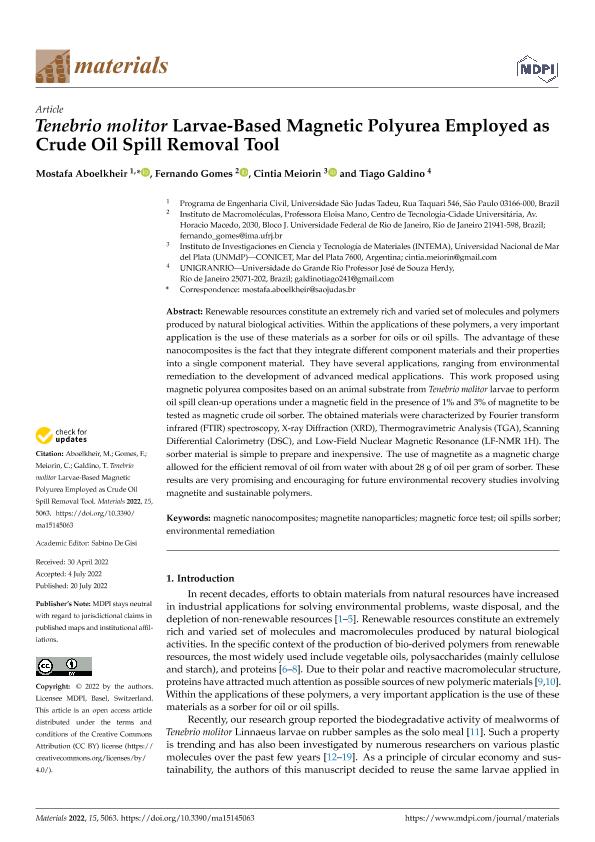Mostrar el registro sencillo del ítem
dc.contributor.author
Aboelkheir, Mostafa
dc.contributor.author
Gomes, Fernando
dc.contributor.author
Meiorin, Cintia

dc.contributor.author
Galdino, Tiago
dc.date.available
2023-09-21T22:35:23Z
dc.date.issued
2022-07
dc.identifier.citation
Aboelkheir, Mostafa; Gomes, Fernando; Meiorin, Cintia; Galdino, Tiago; Tenebrio molitor Larvae-Based Magnetic Polyurea Employed as Crude Oil Spill Removal Tool; Multidisciplinary Digital Publishing Institute; Materials; 15; 14; 7-2022; 1-15
dc.identifier.issn
1996-1944
dc.identifier.uri
http://hdl.handle.net/11336/212599
dc.description.abstract
Renewable resources constitute an extremely rich and varied set of molecules and polymers produced by natural biological activities. Within the applications of these polymers, a very important application is the use of these materials as a sorber for oils or oil spills. The advantage of these nanocomposites is the fact that they integrate different component materials and their properties into a single component material. They have several applications, ranging from environmental remediation to the development of advanced medical applications. This work proposed using magnetic polyurea composites based on an animal substrate from Tenebrio molitor larvae to perform oil spill clean-up operations under a magnetic field in the presence of 1% and 3% of magnetite to be tested as magnetic crude oil sorber. The obtained materials were characterized by Fourier transform infrared (FTIR) spectroscopy, X-ray Diffraction (XRD), Thermogravimetric Analysis (TGA), Scanning Differential Calorimetry (DSC), and Low-Field Nuclear Magnetic Resonance (LF-NMR 1H). The sorber material is simple to prepare and inexpensive. The use of magnetite as a magnetic charge allowed for the efficient removal of oil from water with about 28 g of oil per gram of sorber. These results are very promising and encouraging for future environmental recovery studies involving magnetite and sustainable polymers.
dc.format
application/pdf
dc.language.iso
eng
dc.publisher
Multidisciplinary Digital Publishing Institute
dc.rights
info:eu-repo/semantics/openAccess
dc.rights.uri
https://creativecommons.org/licenses/by/2.5/ar/
dc.subject
ENVIRONMENTAL REMEDIATION
dc.subject
MAGNETIC FORCE TEST
dc.subject
MAGNETIC NANOCOMPOSITES
dc.subject
MAGNETITE NANOPARTICLES
dc.subject
OIL SPILLS SORBER
dc.subject.classification
Ingeniería de los Materiales

dc.subject.classification
Ingeniería de los Materiales

dc.subject.classification
INGENIERÍAS Y TECNOLOGÍAS

dc.title
Tenebrio molitor Larvae-Based Magnetic Polyurea Employed as Crude Oil Spill Removal Tool
dc.type
info:eu-repo/semantics/article
dc.type
info:ar-repo/semantics/artículo
dc.type
info:eu-repo/semantics/publishedVersion
dc.date.updated
2023-06-23T16:36:04Z
dc.journal.volume
15
dc.journal.number
14
dc.journal.pagination
1-15
dc.journal.pais
Suiza

dc.journal.ciudad
Basel
dc.description.fil
Fil: Aboelkheir, Mostafa. Universidade São Judas Tadeu; Brasil
dc.description.fil
Fil: Gomes, Fernando. Universidade Federal do Estado do Rio de Janeiro; Brasil
dc.description.fil
Fil: Meiorin, Cintia. Consejo Nacional de Investigaciones Científicas y Técnicas. Centro Científico Tecnológico Conicet - Mar del Plata. Instituto de Investigaciones en Ciencia y Tecnología de Materiales. Universidad Nacional de Mar del Plata. Facultad de Ingeniería. Instituto de Investigaciones en Ciencia y Tecnología de Materiales; Argentina
dc.description.fil
Fil: Galdino, Tiago. Universidade do Grande Rio Professor José de Souza Herdy; Brasil
dc.journal.title
Materials
dc.relation.alternativeid
info:eu-repo/semantics/altIdentifier/doi/http://dx.doi.org/10.3390/ma15145063
dc.relation.alternativeid
info:eu-repo/semantics/altIdentifier/url/https://www.mdpi.com/1996-1944/15/14/5063
Archivos asociados
